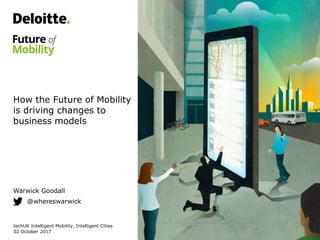
Driving New Mobility Business Models - Deloitte
- 1. How the Future of Mobility is driving changes to business models Warwick Goodall techUK Intelligent Mobility, Intelligent Cities 02 October 2017 @whereswarwick
- 2. 2 Big changes to business models in the Future of Mobility Economics Market Positioning Business Model Questions 1 2 3 1 2 3
- 3. 3 Energy £37bn UK extended mobility ecosystem revenues ~£500bn Finance £37bn Transportation £90bn Automotive £249bn Media £4bn Insurance £14bn Technology £5bn Medical & Legal £8bn Public sector £55bn Stakes are high – with approximately £500bn UK ecosystem Data from 2014-2015 Sources: Deloitte analysis, with data from Office of National Statistics, TechUK, Finance and Leasing Association, Legal Services Board, Department of Communities and Local Government, SMMT, Department for Transport, Magnetic, Statista. Disruption is coming…how will it impact the business model? Decreasing revenuesIncreasing revenues Unchanged TBD
- 4. 4 Converging forces will likely give rise to the emergence of four future states of mobility, which will exist in parallel Personal Shared AutonomousDriverAssisted Vehicle Ownership Vehiclecontrol Shared Autonomous Shared Driver-Driven Personally Owned Autonomous Personally Owned Driver-Driven1 2 3 4 Low Asset efficiency
- 5. 5 Autonomous drive and shared mobility offer significant economic benefits to passengers Source: Deloitte analysis, based on publicly available information (US DOT, AAA, etc). Personal Shared AutonomousDriverAssisted Vehicle Ownership Vehiclecontrol Shared Autonomous Shared Driver-Driven Personally Owned Autonomous Personally Owned Driver-Driven1 2 3 4 Low Asset efficiency The low-cost economics of autonomous drive and shared mobility will be a driving force behind widespread adoption ~$0.97 ~$0.63 ~$0.46 ~$0.31
- 6. 6 The disruptive nature of this transformation will result in massive shifts in economic value Increased consumption of multimedia/ information and value derived from curating holistic in-transit experience Decrease in personally-owned vehicle sales and profound mix shifts. Value shifts to managing end-to-end mobility experience Shared mobility funding rises but may not offset lower levels of personal loans and leasing Rapid growth of AD operating system and mobility management technology & services providers Shifts from personal liability to catastrophic systems-failure insurance Lower energy consumed due to rise of electric vehicles Erosion of tax revenues related to sales/ registration and fuel taxes, parking and traffic citations and shift to dynamic pricing models More efficient last mile delivery lowers costs and accelerates shift away from physical stores Bandwidth greatly expands to meet increased demand for connectivity & reliability Significant reduction in EMS and legal costs as accidents plummet Rise of seamless intermodal transportation and significant increases in efficiency of LH trucking/cargo delivery EnergyFinance TransportInsurance Telecom Automotive Retail Public sector Medical & Legal Technology Media
- 7. 7 Effects on the Automotive Value Chain A multitude of different scenarios across time/markets/segments. • The technology hype cools down • Industry outsiders like Uber enter the market and provide affordable mass mobility • Strong displacement competition • The automotive value chain remains mostly unchanged • Hype around connectivity technologies is gone – cars are mere vehicles for transportation Below technological possibilities Suppliers and outsiders set the rules OEMs dominate the automotive world • OEMs dominate the automotive value chain through gated platforms • OEMs set standards for connected services and modern life infrastructure The fallen giant • Cars are software based high- tech products with OEMs providing the shell • Tech players manage in-vehicle services and platforms Hardware platform provider Data & mobility manager Stagnant car maker of Power CapabilitiesofCars Balance To the full extent
- 8. 8 Changing business models The “Fourth Emergency Service” From a model based on road-side assistance… … to a digital service to predict and prevent break-downs • AA Car Genie uses state-of-the art Internet of Things (IoT) technologies • Real-time data flow to AA help desk • Predictive analytics to spot trouble before it happens
- 9. 9 Merging business models will generate value to multiple players Citymapper’s Project Black Bus Journey planner Data insight Taxi platform Taxi drivers
- 10. 10 Mobility as a Service (MaaS) players provide a service that orchestrates the supply and demand for transportation to move people and goods MaaS Provider Characteristics 1.User-facing interface (such as a mobile app) 2.Integration across transportation modes 3.Seamless planning through to payment 4.Subscription and/or transactional-based billing If Netflix’s business model was applied to urban transportation, how might that change the way city dwellers get around?
- 11. 11 More business model questions to be explored What will the mobility operating platform look like? Will users pay for transportation, or will other services generate more revenue? What is the impact and role of regulators in constraining business models? Who processes and monetises the data?
- 12. 12 1 Industries rise and fall. Cycles take long periods to play out but eventually change occurs. 2 The system benefits and fundamental economics of the Future of Mobility are overwhelmingly compelling. 3 There is a pathway for legacy incumbents to lead the transition to the future of mobility, but this will require fundamental and expeditious business model change and major investment. 4 Collaboration across the ecosystem will continue to increase as new value capture opportunities arise. 5 Future market leadership will be gained from determining “where to play” and “how to win” in a more complex and expansive mobility ecosystem. As the new business models evolve, organisations could benefit from recognising the following:
- 13. 13 Deloitte Perspectives on The Future of MobilityTM www.deloitte.com/FOM @whereswarwick
